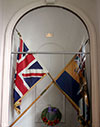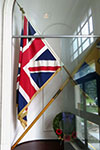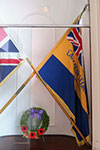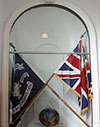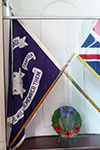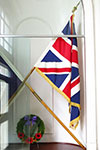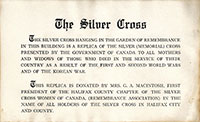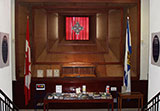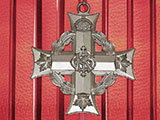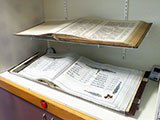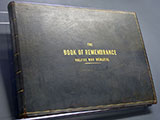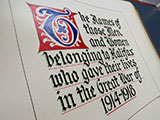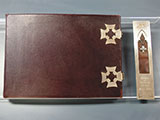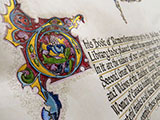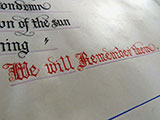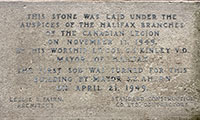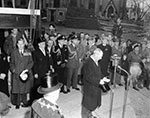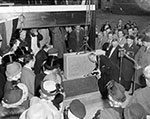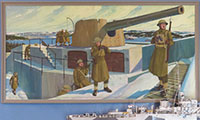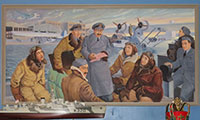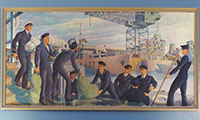Library as a Living Memorial
The concept of creating a living memorial was an inspired idea. Still feeling the effects of two world wars, advocates and their supporters felt that a statue or fixed memorial was not enough. A library, as a public institution whose mandate it is to promote freedom of speech, was deemed to be a fitting honour for those who lost their lives defending these very ideals.
Along with the activities of the public honouring men and women of war, the library included important physical war memorial elements within the building itself. There would prove to be two phases of war memorial inclusions.
- June 14, 1951 - Silver Cross public dedication to mothers and wives of fallen soldiers
- May 29, 1955 - Book of Remembrance ceremony
- August 2, 1959 - City Council approval of funding for new memorial artifacts
- June 1961 - Renovations including addition of new artifacts
- November 11, 1961 - Unveiling and dedication of memorial
Newspaper Articles
- August 2, 1959 - Approve War Memorial For Public Library Lobby - The Halifax Mail-Star (pdf)
- November 8, 1961 - Veterans To Parade: Remembrance Program Set - The Halifax Mail-Star (pdf)
Memorial Renovations
- November 20, 1950 - Memorial Artifacts (pdf)
- November 25, 1950 - Approval of Proposals (pdf)
- June 9, 1961 - Progress of Memorial Renovations (pdf)
- November 11, 1961 - Dedication Invitation (pdf)
Memorial Artifacts
Flags and Standards
Glass cases on each side of the main Library entrance were home to flags and standards. One case contained a Union Jack and a flag of the British Empire Service League. The other case contained the two standards of the Silver Cross Women of Canada. Upon the opening of the new Central Library, these items may be viewed at Maritime Command Museum.
Silver Cross
The Silver Cross, which hung in the Library, is a replica of the Silver Cross presented by the Government of Canada to all mothers and widows of those who died in the service of their country during World War I, World War II, and the Korean War. It was donated to the Library in 1950 by Mrs. G. A. MacIntosh, first president of the Halifax County Chapter of the Silver Cross Women of Canada. Its original home in the Library was in the midst of an indoor garden known as the Garden of Remembrance - November 13, 1951 - Has Place of Honor, Silver Cross... - The Halifax Mail-Star (pdf). Upon the opening of the new Central Library, the Silver Cross may be viewed at the Maritime Command Museum.
Books of Remembrance
The two Books of Remembrance list the names of the men and women of Halifax County who perished in World War I, World War II, and the Korean War. The first Book of Remembrance, dedicated to the city on July 2, 1929, remembers 1,360 individuals who died in the Great War. The second book, which lists the 705 individuals who were killed in World War II and the Korean War, was donated to the Library in 1955 by the Silver Cross Women of Canada. Both books have remained with the Library and may be viewed near the Local History Room of Central Library's fourth floor. The Books of Remembrance have also been digitized and are available on the Halifax Public Libraries website.
- June 12, 1951 - Book Of Remembrance - The Halifax Mail-Star (pdf)
- June 14, 1951 - Tag Sale Saturday To Raise Remembrance Book Funds - The Halifax Mail-Star (pdf)
- February 13, 1952 - Provide Funds For Book Of Remembrance - The Halifax Mail-Star (pdf)
- May 29, 1955 - Book Of Remembrance Booklet (pdf)
- May 31, 1955 - Impressive Ceremony - Book Of Remembrance - The Halifax Mail-Star (pdf)
Cornerstone
Mayor Gordon S. Kinley laid the cornerstone following a service at the Cenotaph on November 11, 1949. Hundreds of veterans and citizens crowded Grafton Park that day to be a part of the ceremony.
“This stone was laid under the auspices of the Halifax Branches of the Canadian Legion on November 11, 1949 by His Worship Lt. Col. GS Kinley, VD, Mayor of Halifax. The sod was turned for this building by Mayor JE Ahern on April 21, 1949.”
The Halifax Herald Ltd. Photos:
Posted with permission from The Halifax Herald Ltd. Interested in buying these photos? Contact The Chronicle Herald Library 902-426-2811, ext. 3080 or 3384; library@herald.ca
Plaque
The plaque was designed by Alderman A.H. MacMillan and was constructed of bronze with aluminum fittings and will remain on-site.
“This building was erected in memory of those who gave their lives in defense of their country 1914-1918 1939-1945. For their faith – for their courage – for their sacrifice, we will remember them.”
- November 2, 1950 - Alderman Designs Plaque - The Halifax Mail-Star (pdf)
- November 3, 1951 - Plaque Will Be Placed In New Library - The Halifax Mail-Star (pdf)
Murals
Three murals were commissioned and painted by local artist Commander Donald Cameron MacKay in 1951. Donald Cameron Mackay was the principal of the Nova Scotia College of Art and he served in the Royal Canadian Navy, for part of his six years as a war artist. The murals depict the role of the servicemen during the war years. They were exhibited in the Library for many years until they were donated to the Maritime Command Museum (CFB Halifax) in 1974.

